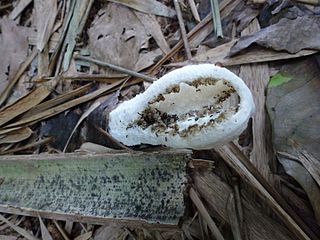
Gymnophthalmidae is a family of lizards with at least 250 species, sometimes known commonly as spectacled lizards or microteiids. They are called "spectacled" because of their transparent lower eyelids, which allow them to still see with closed eyes. As in most lizards, except geckos, these eyelids are movable. The Alopoglossidae have been recently moved from this family.
Leposoma is a genus of South American lizards in the family Gymnophthalmidae.
The four-toed amapasaurus is a lizard that was discovered in 1970 by Osvaldo Rodrigues da Cunha. It is the only species in the genus Amapasaurus.

The prehensile-tailed porcupines or coendous are found in Central and South America. Two other formerly recognized Neotropical tree porcupine genera, Echinoprocta and Sphiggurus, have been subsumed into Coendou, since Sphiggurus was shown by genetic studies to be polyphyletic, while Echinoprocta nested within Coendou.

The Ubajara National Park is a national park in the state of Ceará, Brazil. It is the smallest of the 35 national parks of Brazil and is known for the Ubajara grotto.

Adelophryne baturitensis is a species of frog in the family Eleutherodactylidae. It is endemic to north-eastern Brazil and is known from its type locality, Serra de Baturité in the state of Ceará.

Blumenavia is a genus of fungi in the family Phallaceae. The genus contains three species found in South America and Africa.

The Serra da Ibiapaba Environmental Protection Area is an environmental protection area in the states of Piauí and Ceará, Brazil. It contains fragments of cerrado, caatinga and Atlantic Forest, and is home to the endangered red-handed howler.
Leposoma annectans is a species of lizard in the family Gymnophthalmidae. It is endemic to Brazil.
Leposoma nanodactylus is a species of lizard in the family Gymnophthalmidae. It is endemic to Brazil.
Leposoma puk is a species of lizard in the family Gymnophthalmidae. It is endemic to Brazil.

The skink tegu is a species of lizard in the family Gymnophthalmidae. It is endemic to Brazil.
Leposoma sinepollex is a species of lizard in the family Gymnophthalmidae. It is endemic to Brazil. It has lanceolate ventral and elongate dorsal scales arranged in diagonal rows. Males of this species have black pigmentation in their ventral parts, while females have a creamy pigmentation.
Loxopholis ferreirai is a species of lizard in the family Gymnophthalmidae. The species is endemic to Brazil.
Loxopholis osvaldoi is a species of lizard in the family Gymnophthalmidae. The species is endemic to Brazil.
Loxopholis snethlageae is a species of lizard in the family Gymnophthalmidae. The species is endemic to Brazil.

Loxopholis southi, also known commonly as the northern spectacled lizard and the southern leposoma, is a species of lizard in the family Gymnophthalmidae. The species is native to southeastern Central America and northwestern South America. There are two recognized subspecies.

The Baturite porcupine is a nocturnal species of rodent in the family Erethizontidae that is found in Brazil. The name refers to the locality of origin, a forests on a mountain range similar to the Brejos de Altitude of the Brazilian Northeast where a fauna different from that of the surrounding semiarid Caatinga can be found.








